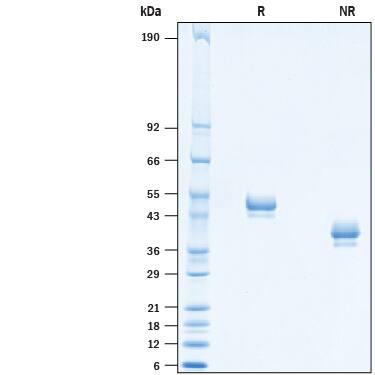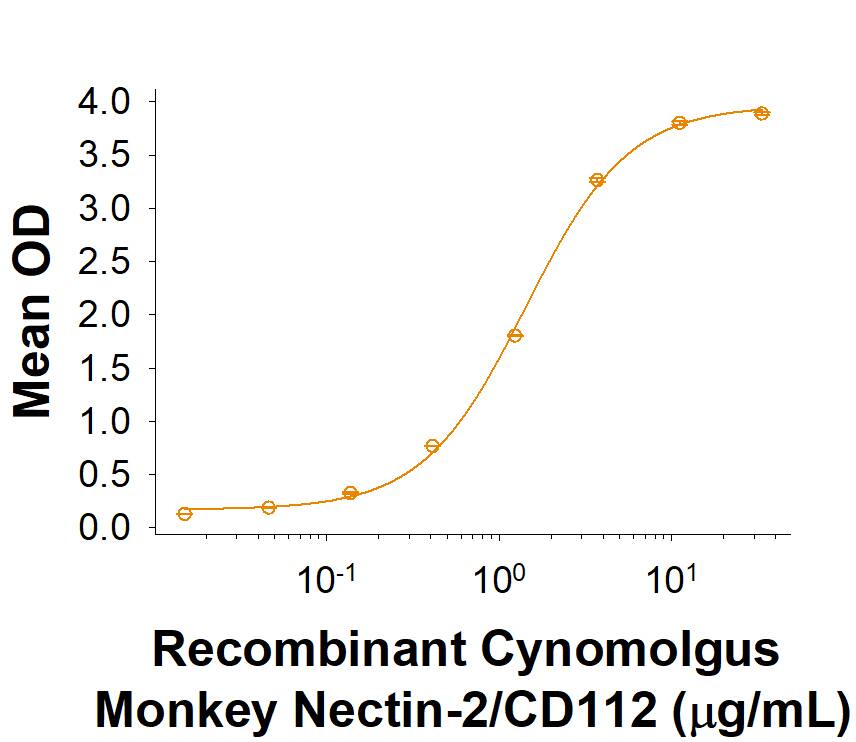Recombinant Cynomolgus Monkey Nectin-2/CD112 His Protein, CF
R&D Systems, part of Bio-Techne | Catalog # 10617-N2

Key Product Details
Product Specifications
Source
Gln32-Gly360, with a C-terminal 6-His tag
Purity
Endotoxin Level
N-terminal Sequence Analysis
Predicted Molecular Mass
SDS-PAGE
Activity
When Recombinant Cynomolgus DNAM-1/CD226 Fc Chimera (Catalog # 9276-DN) is immobilized at 1 ug/mL, 100 uL/well, Recombinant Cynomolgus Monkey Nectin-2/CD112 His-tag Protein binds with an ED50 of 0.4-2.4 ug/mL.
Scientific Data Images for Recombinant Cynomolgus Monkey Nectin-2/CD112 His Protein, CF
Recombinant Cynomolgus Monkey DNAM-1/CD226 Fc Chimera Protein Binding Activity.
When Recombinant Cynomolgus Monkey DNAM-1/CD226 Fc Chimera (9276-DN) is immobilized at 1 μg/mL, 100 μL/well, Recombinant Cynomolgus Monkey Nectin-2/CD112 His-tag (Catalog # 10617-N2) binds with an ED50 of 0.4-2.4 μg/mL.Recombinant Cynomolgus Monkey Nectin-2/CD112 His-tag Protein SDS-PAGE.
2 μg/lane of Recombinant Cynomolgus Monkey Nectin-2/CD112 His-tag Protein (Catalog # 10617-N2) was resolved with SDS-PAGE under reducing (R) and non-reducing (NR) conditions and visualized by Coomassie® Blue staining, showing bands at 41-50 kDa and 35-43 kDa, respectively.Formulation, Preparation and Storage
10617-N2
| Formulation | Lyophilized from a 0.2 μm filtered solution in PBS with Trehalose. |
| Reconstitution | Reconstitute at 500 μg/mL in PBS. |
| Shipping | The product is shipped at ambient temperature. Upon receipt, store it immediately at the temperature recommended below. |
| Stability & Storage | Use a manual defrost freezer and avoid repeated freeze-thaw cycles.
|
Background: Nectin-2/CD112
Nectins are a small family of Ca++-independent immunoglobulin (Ig)-like cell adhesion molecules (CAMs) that organize intercellular junctions (1). The nectin family has at least four members (nectin-1-4), all of which show alternate splicing (except for Nectin-4), a transmembrane (TM) region (except for Nectin-1 gamma), and three extracellular Ig-domains. Nectins are highly homologous to the human receptor for poliovirus, and as such have been alternately named poliovirus receptor-related proteins. They do not, however, appear to bind poliovirus (1). Nectin-2 is a type I TM glycoprotein that is found on a variety of cell types (2, 3). Cynomolgus Nectin-2 is synthesized as a 538 amino acid precursor. It contains a 31 amino acid (aa) signal sequence, a 329 aa extracellular domain (ECD), a 22 aa TM segment, and a 156 aa cytoplasmic domain. The ECD contains one N-terminal V-type Ig domain and two C2-type Ig domains. The V-domain is believed to mediate nectin binding to its ligands (4). The ECD of cynomolgus Nectin-2 shows 96% aa sequence identity with the ECD of human Nectin-2. Nectin-2 is known to bind the pseudorabies virus, and herpes simplex virus-2 (HSV-2), but not HSV-1. It does not bind poliovirus. As a cell adhesion molecule, Nectin-2 will form cis-homodimers (same cell), followed by trans-dimers (across cells). Nectin-2 will not cis-dimerize with other nectins, but will cis-dimerize with its two splice forms. Notably, a Nectin-2 cis-dimer on one cell will heterodimerize with a Nectin-3 cis-dimer on another cell (1). Nectin-2 is found concentrated in adherens junctions, and exists on neurons, endothelial cells, epithelial cells and fibroblasts.
References
- Takai, Y. and H. Nakanishi, 2003, J. Cell Sci. 116:17.
- Bottino, C. et al. (2003) J. Exp. Med. 198:557.
- Pende, D. et al. (2005) Mol. Immunol. 42:463.
- Struyf, F. et al. (2002) J. Virol. 76:12940.
Long Name
Alternate Names
Gene Symbol
UniProt
Additional Nectin-2/CD112 Products
Product Documents for Recombinant Cynomolgus Monkey Nectin-2/CD112 His Protein, CF
Product Specific Notices for Recombinant Cynomolgus Monkey Nectin-2/CD112 His Protein, CF
For research use only

